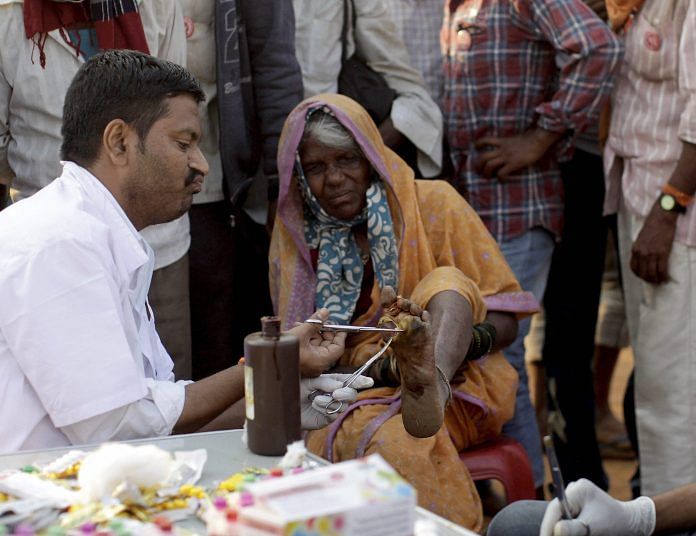Our encounter with farmers has a quality of suddenness, as if it was not meant to be.
Now that urban Indians are done posting pictures of farmers, and some kinder ones providing tea and biscuits, it is time to ask some questions about this occasional relationship.
In a Hindi story called Stepney, a farmer whose land had been confiscated by his brother, is made to visit the city and meet the ‘sarkar’ to get his complaint heard and attended to. What follows in the story are a series of episodes in dark humour – when the farmer wonders what this sarkar, claiming to be ‘aapki sarkar, gatisheel sarkar’ looks like. Upon seeing a Government of India car, the farmer moves close, only to be barked at by a dog. Then the vehicle of the gatisheel speedy state orders him to become its spare wheel. The speedy state needs not only the farmer’s produce, but also his body to surge ahead.
This story came to mind when the recent Long March by farmers in Maharashtra resolutely registered their presence in the urban imagination. It’s a different matter that the images of blistered feet, hashtags and Facebook posts may have already been pushed down in memory and become obsolete.
But this reinforces the sorry truth, that the sarkar remains elusive and hypothetical for many in rural India. And the city, as the seat of administration, adds to the distance between hinterland farmers and the justice they seek. The city also remains oblivious of the material reality of rural people for much of the time. The people in the city wake up to their reality when the farmers-turned-labourers need to go home.
The Kisan Long March broke this cycle momentarily, albeit by efforts the farmers themselves had to make. The cycle of apathy was not broken by those living in the cities. This is one of the deepest malaises of our urban lives–that its experience and legitimacy stems from, and ends, around us. Those who fall beyond the pale exist as exceptions, as afterthoughts. And the encounter with them has a quality of suddenness, as if it was not meant to be.
I am fully aware of the civic support that the farmers received from Mumbai. But I wish to point out the ‘extra-ordinariness’ of this encounter. The city and the farm do not always have to be integrated, and they may continue to share an uneasy, as well as symbiotic, relationship. However, the figure of the farmer does not need to impinge upon the mind of an urban Indian only through sudden, and disaster-driven, situations.
The root of this phenomenon lies, of course, in the structural nature of economic exchange which makes the material life of the farmer, as well his/her physical presence invisible, unless contingencies bring farmers to courts of appeal. Cultural representations also replicate the same economic biases, instead of intervening in them. Some of us hear of farmers’ suicides only through Peepli Live. And once the film is over, we may think that reality also came with a three-hour shelf life.
On the other hand, think of the works of writers like Tarashankar Bandopadhyaya and Pannalal Patel, or filmmakers like Bimal Roy and Shyam Benegal, who ensured that we were not once-in-a-while voyeurs of farmers’ lives, but complicit and connected to them. And even if we were to think of films in the 1970s with idyllic villages that glossed over the more day-to-day struggles of indebtedness, and showed us only the gaon ki gori, a farmer singing songs, or his exploitation in the big bad city, the worlds of the rural and urban were not so unconnected.
Was it to safeguard against this amnesia that intellectuals, writers, nationalists in the early decades of the twentieth century sent their protagonists to villages? Is that why Gora was made to go to a village in Rabindranath Tagore’s famous novel? Or Munshi Premchand made us hear Hori’s story, and reminded his son Gobar to appreciate a semblance of dignity the village still provided, when compared to the city?
It’s possible to look back, from Do Bigha Zameen and Mother India to Upkaar and many others, when the farmer was regular in our cultural representation. He was not an occasional outsider, whose presence was made real only when he decided to march to the city. None of this is to deny the enormous psychological and political possibilities that are inherent in the march, but it is to sound caution about an inexorable forgetfulness.
Rita Kothari is professor (English) at Ashoka University.



